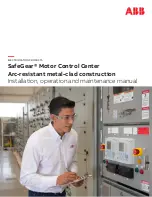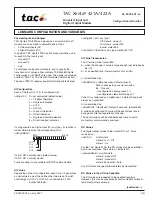
I N S TA L L AT I O N , O P ER AT I O N A N D M A I N T EN A N C E M A N UA L
6
Attaching to the Floor
Following the removal of the shipping bases, the MCC units should be secured to the floor either by bolting
per the guidelines outlined on the ABB factory drawings. Welding is not recommended and no guidelines
exist for attachment using this method.
Connections
Bolt the separate units together. Reconnect the main bus and control wiring at the shipping splits. Follow
the connection diagram when replacing secondary and control wiring.
Bolted connections should be torqued to required levels as outlined in Appendix C.
Complete all internal connections. Make the external connections to control power sources and circuits, to
secondary and potential circuits, to feeders, power sources and to ground.
Note: After completing all connections to secondary (control) circuits, follow these circuits and remove temporary connections from current
transformer secondaries (see Figure 1).
Temporary jumpers protect against voltages that may occur if the current transformer primaries carry
currents while the secondary circuits are still not complete. With the secondary circuits connected, remove
the jumpers.
Power cable penetrations, top entry or bottom entry, into the equipment should be secured in the provided gland
plates with sealing glands/hubs. Failure to use sealing glands/hubs will affect the arc-resistant performance of
the MCC.
Ground bus connections should not penetrate any part of the MCC not intended for cable of bus entrance. Not
following this practice will affect the arc- resistant performance of the MCC.
Note: Failure to remove the jumpers will interfere with meters, relays, or other devices in these circuits (see Figure 1).
WARNING
CAUTION
Before making primary source connections, verify that the primary cables are de-energized and the
equipment is properly grounded.
DANGER
Fig. 1 CT Shorting Blocks










































